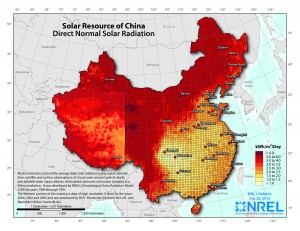Solar thermal is experiencing an industrial reform, the iconic signal of which is the breaking of traditional industrial boundary as the leading solar companies are transforming and expanding toward integrated suppliers of thermal energy, thermoelectricity and multi-energy. In the 7th China New Energy International Summit Forum held recently, Xu Xinjian, Board Chairman of Solareast and a leader of solar energy industry, stated the direction of the reform by using the words “broad solar thermal”. He reckoned that “broad solar thermal” was to break the existing industrial boundary, realize technical upgrading from low temperature to medium and high temperature, and extend from water heating to thermal energy and thermoelectricity area, and at the same time open up industries like solar energy and air energy with an industrial thinking of openness and fusion and realize horizontal expansion.
“Broad solar thermal” era is coming
Different from the photovoltaic, the development of solar thermal has only solid steps but has seldom haloes and ups and downs. After nearly ten years’ high-speed development, the annual output value of solar thermal has been close to RMB 100 billion Yuan. The annual output volume of solar thermal collector has been over 42 million square meters, accounting for over 70 percent of the world; the solar energy installation population has reached 145 million square meters, accounting for more than 80 percent of the world. At the same time, 95 percent of the production capacity of solar thermal is consumed internally, and its energy saving contribution is getting prominent day by day. In the first half year, Ministry of Industry and Information Technology issued Guidelines for Promoting the Healthy Development of the Solar Water Heater Industry, which clearly mentioned to promote the optimizing and upgrading of solar water heater industry, fully exert the scale effect of industrial cluster, and cultivate three leading enterprises with annual production and sales volume over 2.5 million to the year of 2015.
However, “broad solar thermal” will go further than that. Li Jun, President of Siji Micoe, said that except for solar water heating, high and medium temperature thermal energy, high temperature thermoelectricity field, which have trillion Yuan scale, yet need to be developed. In solar energy field, hot water lower than 100 centigrade is low temperature, 100 to 250 centigrade is medium temperature, 250 to 400 centigrade is high temperature, the high and medium temperature can be widely applied in industrial field. Take solar boiler for example, China has over 0.5 million sets industrial coal-fired boilers, if we apply solar energy in low temperature preheating and medium temperature heating, we can save about 40 million tons raw coal and reduce about 80 million tons carbon dioxide per year. Experts predict that the industrial boiler only can drive a 1.3 trillion Yuan valued solar energy market.
Moreover, the reporter was told that medium temperature solar energy technologies has been very mature at present, it is widely used in many printing and dyeing enterprises in South Jiangsu and is proved to have evident energy-saving effect. In industrial fields such as textile, food and sea water desalination, the application of medium temperature solar energy has achieved breakthrough and it shall have a huge market potential. Although there were lots of fetters, the recent Research Report on the Policies of China’s Solar Power Industry, which was jointly compiled by National Solar Thermal Energy Alliance and China National Renewable Energy Center, is interpreted by insiders that China’s solar power shall enter into scale development period.
Convergence, cross-circle and innovation
Some solar experts said that “broad solar thermal” is an outbreak under the historical background, strategic expansion with the theme of “convergence” has opened the integrated innovation space for solar thermal industry. The leading enterprises have a clear idea about this. Li Jun said that “broad solar thermal” is the direction, and as far as the enterprise strategy is concerned, the current task is to focus on solar thermal, and transform from single energy to multiple energies and from single water heating to high and medium temperature fields like thermal energy and thermoelectricity through technology innovation and the combination of multi-energy technologies. At the same time he also emphasized:” Multi-energy composite application technology and energy reserve technology is a very important step during the process of industrial convergence”.
This technology block has been conquered looking at the market pattern, and industrial convergence is accelerating. Shunde Industrial Park Phase-I of Siji Micoe, with an annual production capacity of 0.3 million sets air-energy water heater, has been built and has become one of the biggest air-energy research and development and manufacturing bases of the industry.
Industrial convergence has an all-round influence on solar energy industry, all the aspects such as operation concept, profiting mode, technology research and development, and market layout will be affected directly. For example, the convergence of solar energy and construction industry, urban energy-saving has caused the sales surge of panel and balcony wall-hanging solar energy, pushed the transformation of solar energy from single-machine sales to heat water systematic engineering, and has put forward higher requirements on the energy-saving parameters, the composite application of multi-energy and the intelligence of the system. During the convergence of solar energy and construction, demand of urban residents on solar heating system has also promoted the maturity of enterprises’ thermal energy technology. In addition, “broad solar thermal” not only pushes the own development of solar energy industry, but also gives impetus to associate industries. Photo-thermal has a long industrial chain covering tens of industries from the most upstream to the most downstream, the leap-forward development of solar energy industry shall offer more market opportunities for traditional industries like glass and steel industry that have been in overcapacity for a long time.



